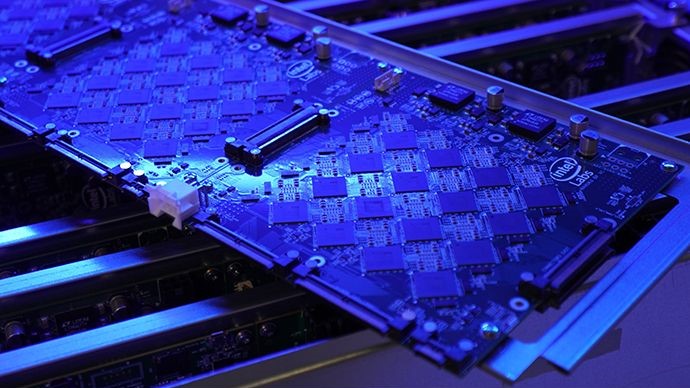Intel's New Research System Has the Neural Capacity of a Small Mammal Brain
Intel's Pohoiki Springs features the computational capacity of 100 million neurons.

Intel today announced it has reached a new milestone for its neuromorphic chip called Loihi. It comes in the form of a system targeting research that's packed with 786 Loihi chips for a total of over 100 million neurons. The system goes by Pohoiki Springs and is available to Intel’s research community members through the cloud and programmed via an SDK.
Pohoiki Springs: Powered by Loihi
Intel unveiled Loihi in 2017. It's a (spiking) neural network chip more closely inspired by the brain than conventional deep learning, and in recent research Intel even learned Loihi to smell scents -- or "mimic what happens in your brain’s neural network when you smell something" as Intel put it.
- The best gaming CPUs of 2020
- The best (non-gaming) performance CPUs of 2020
- PS5 specs revealed: Details from Sony's livestream
One 14nm Loihi chip comprises a 60mm-squared chip and 2 billion transistors. It can process certain specific workloads up to 1,000 times faster and 10,000 times more efficient than standard processors, so a system with 786 of them might deliver unprecedented performance in some workloads. according to Intel.
The new Pohoiki Springs system comprises 786 Loihi chips, which means it packs a total of 1.5 trillion transistors on almost 50,000mm-squared of silicon. This gives it a total of 100 million transistors. Despite this enormous scale, Intel said it operates at under 500W, due to it using an asynchronous architecture: there is no global clock on which all transistors switch simultaneously.
As Intel’s largest neuromorphic system to date, Pohoiki Springs is mounted in a data center rack. The chassis is the size of five standard servers (5U) amd consists of eight "rows" that each contain three 32-chip Intel Nahuku boards.

Pohoiki Springs has an amount of neurons comparable to small mammals and should be capable of supporting more advanced neuromorphic workloads, although Intel cautions that it is still in the research phase.
Intel provided three categories where Loihi excels: constraint satisfaction, searching graphs and patterns, such as finding the shortest paths, and optimization problems.
Get Tom's Hardware's best news and in-depth reviews, straight to your inbox.
Intel set out use Loihi in more powerful designs by scaling the numbers of chips. Last year, it released the 64-chip Pohoiki Beach system with 8 million neurons. Using Loihi, Intel also started a neuromorphic research community (INRS) to research all aspects of the neuromorphic computing, towards commercialization. To that end, last year the first Global 500 companies joined this community.
Applications: Teaching Loihi to Smell
Even a system with two Loihi chips can support real-time edge workloads using milliwatts of power. Some examples Intel provided include recognizing gestures, reading braille using artificial skin, orient direction using learned visual landmarks and learning new odor patterns. Intel said those proof of concepts have shown excellent scalability.
Also this week, Intel announced that it had trained Loihi as a sort of “artificial nose” capable of identifying the scents of hazardous chemicals. The company paired Loihi with the output of 72 chemical sensors whose outputs corresponded to particular smells, such as acetone, ammonia and methane. Loihi would learn that a particular response corresponded to a particular chemical.
“My next step is to generalize this approach to a wider range of problems—from sensory scene analysis (understanding the relationships between objects you observe) to abstract problems like planning and decision-making,” said Nabil Imam, a senior research scientist in Intel Lab’s neuromorphic computing group, in a statement. “Understanding how the brain’s neural circuits solve these complex computational problems will provide important clues for designing efficient and robust machine intelligence.”
-
jkflipflop98 Async processing you say? Gee Whiz. . . I wonder if that will ever happen to desktop processors in the future?Reply -
InvalidError Reply
Most software developers are already struggling with boring old multi-threading, I doubt they'll be ready for massively parallel asynchronous programming any time soon.jkflipflop98 said:Async processing you say? Gee Whiz. . . I wonder if that will ever happen to desktop processors in the future? -
jkflipflop98 ReplyInvalidError said:Most software developers are already struggling with boring old multi-threading, I doubt they'll be ready for massively parallel asynchronous programming any time soon.
It wasn't really a question. . .